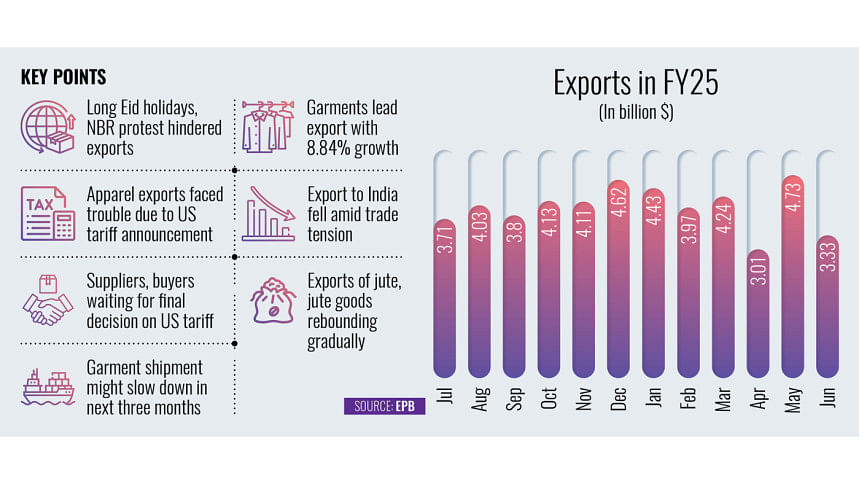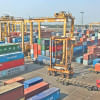Exports rose 8% to $48b in FY25 despite economic headwinds

Bangladesh's merchandise exports grew by 8.58 percent in the just-concluded fiscal year (FY) 2024-25, reaching $48.28 billion, defying a global economic slowdown, ongoing geopolitical tensions, and domestic instability, according to data released by the Export Promotion Bureau (EPB) yesterday.
"The export could have been much more had there not been long Eid holidays in June during Eid-ul-Azha when production in factories did not take place," EPB Vice-Chairman Md Anwar Hossain told The Daily Star over the phone.
Apart from Eid holidays, he said exports also faced disruptions due to protests by officials of the National Board of Revenue (NBR), which brought customs operations to a standstill for a significant stretch in May and June.
These disruptions, coupled with other hurdles, likely contributed to the 7.55 percent drop in exports in June, which fell to $3.33 billion compared with the same month last year.
Moreover, exports to India fell because of trade tensions between the two neighbours, Hossain also said.
The garment industry, which accounts for nearly 84 percent of national export earnings, drove much of the growth in FY25, despite frequent unrest and factory closures.
Garment exports rose by 8.84 percent year-on-year to $39.34 billion, with knitwear alone earning $21.15 billion, marking a 9.73 percent increase. Woven garments brought in $18.18 billion, up 7.82 percent from the previous year, EPB data show.
Apart from factory closures and long Eid holidays, the 37 percent reciprocal tariffs announced by the United States on April 2 also spelled trouble for the garments sector.
"The tariff announcement by the Donald Trump administration affected overall merchandise shipments from Bangladesh in the last fiscal year, as exporters, mainly apparel exporters, faced trouble from the sudden tariff blow," said EPB Vice-Chairman Hossain.
Faruque Hassan, former president of the Bangladesh Garment Manufacturers and Exporters Association (BGMEA), echoed similar concerns.
He warned that shipments are likely to slow over the next three months—July, August, and September—as US retailers and brands remain hesitant to confirm new orders.
"Because both local suppliers and American buyers are waiting for the Trump administration's final reciprocal tariff rate," he said.
Hassan, however, expects that garment shipments to the USA will start to grow again from October onwards, as buyers will have the confirmed tariff rates and the lean season will be over. Furthermore, October will mark the beginning of the peak sales season in the USA, which will further contribute to increased shipments.
The decision on the looming US tariff is expected to come by July 9, when the announced 90-day pause on the reciprocal tariff imposition is set to end. In the meantime, US customs agents began collecting Trump's unilateral 10 percent tariff on all imports from many countries shortly after the April announcement. This is also expected to affect exports.
As of now, US buyers have offered to bear a portion of the 10 percent baseline tariff and have asked local suppliers to bear the remaining portion with the help of fabric suppliers, retailers, and brands. Usually, the tax burden is borne by the importing companies.
Speaking on the issue, BGMEA President Mahmud Hasan Khan Babu said, "The future trend of garment exports should maintain this rate as the global supply chain is recovering gradually.
"If the current 10 percent baseline tariff also continues for other competitive countries, Bangladesh's garment exports are likely to continue growing by at least 10 percent."
Apart from garment items, the shipment of leather and leather goods performed well and grew by 10.19 percent to reach $1.14 billion, as per EPB data.
Besides, the export of home textiles grew by 2.42 percent to reach $871.57 million, reflecting increasing confidence of international buyers in Bangladesh.
Frozen food exports grew by 17.23 percent to $441.58 million, EPB data also show.
Plastic goods exports grew by 16.21 percent to $284.05 million, and ceramic exports grew by 6.44 percent to $35.22 million, according to the data.
Pharmaceutical exports grew by 3.74 percent to $213.16 million.
Headgear exports grew by 11.26 percent to $364.46 million, and non-leather footwear exports grew by 25.37 percent to $522.59 million. Wigs and human hair rose by 20.92 percent to $142.85 million, the data also said.
However, some promising goods such as jute and jute goods, cotton and cotton goods including yarn, vegetables, cement, and terry towels could not perform well last fiscal year, according to EPB data.
Md Abul Hossain, chairman of the Bangladesh Jute Mills Association, said, "The demand for jute and jute goods has been rising all over the world as consumers are abandoning plastic goods to save the environment.
"The days of jute and jute goods are coming back again in Bangladesh," he stated.

 For all latest news, follow The Daily Star's Google News channel.
For all latest news, follow The Daily Star's Google News channel. 








Comments